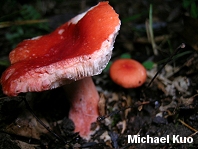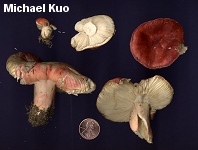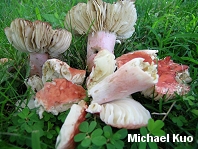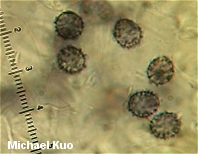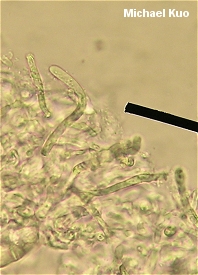| Major Groups > Gilled Mushrooms > Pale-Spored > Russula > Russula tenuiceps |

|
Russula tenuiceps [ Basidiomycetes > Russulales > Russulaceae > Russula . . . ] by Michael Kuo Charles Kauffman (1909) named this mushroom Russula tenuiceps (the "feeble capped russula") in order to emphasize its most distinctive feature: though it is a medium sized to large mushroom, its flesh is incredibly fragile and soon disintegrates. In fact the stem can become a hollow, brittle shell within a few hours, making Russula tenuiceps difficult to pick and take home to study in one piece. Russula tenuiceps is associated with oaks in eastern North America, and it shares many features with mushrooms in the Russula sanguinea group--including the red cap and stem, the yellowish to yellow spore print, and the acrid taste. Kauffman's original concept of this species (which he conceded was broad and might include "several forms") was in my opinion lost as later mycologists redefined and redescribed the mushroom. In particular the association with oaks and the extremely fragile flesh that inspired the Latin name have been de-emphasized or forgotten, in favor of microscopic characters that are, in my opinion, less likely to be predictive. Russula tenuiceps is so fragile that handling it casually usually results in a crumbled mess; the stem becomes hollow and brittle within a few hours of maturity, and the cap quickly falls apart. Studying Kauffman's original type collection for the species, Fatto (2002, p. 234) notes that one of the two specimens is missing a complete stem, and that both specimens "had apparently originally been consumed by maggots." My guess is that maggots had little to do with the decay and that the specimens simply demonstrate the fragile flesh Kauffman described; it is difficult to pick and preserve complete specimens. Fatto concentrates on microscopic details instead, and even eliminates with ellipses Kauffman's sentence about fragile flesh when he quotes the original description. In the same paper Fatto describes Russula subtenuiceps, which he separates on the basis of spore ornamentation, morphology of hymenial cystidia, and the frequency of pileocystidia (as well as their reaction--gray or black--to sulphovanillin), ignoring the fact that his description calls for a "firm-brittle" cap and a "stuffed" stem, as well as an association with spruce or hemlock. The mushroom that some West Coast collectors are calling "Russula tenuiceps" is not the one featured here, and does not appear to agree with Kauffman's original concept. Description: Ecology: Mycorrhizal with oaks--especially northern red oak--and perhaps with other hardwoods; growing alone, scattered, or gregariously; summer and fall; widely distributed in eastern North America. Cap: 7-12 cm; convex when young, becoming broadly convex to flat, sometimes with a shallow depression; sticky when fresh or wet; fairly smooth, or with low wrinkles; bright red but sometimes fading in age; the margin lined at maturity; the skin peeling fairly easily, often over halfway to the center. Gills: Attached to the stem or running slightly down it; close or crowded; white when young but dull yellow with maturity. Stem: 5-9 cm long; 2-2.5 cm thick; fragile and soon hollowing; flushed red over a white base color; dry; fairly smooth. Flesh: Fragile; white; unchanging when sliced. Odor and Taste: Odor not distinctive; taste strongly acrid (sometimes slowly so). Spore Print: Yellowish to orangish yellow. Chemical Reactions: KOH on cap surface negative to yellowish or orangish; iron salts on stem surface negative to slowly pinkish. Microscopic Features: Spores 6-9 x 5-7 µ; with warts REFERENCES: Kauffman, 1909. (Saccardo, 1912; Burlingham, 1915; Beardslee, 1918; Kauffman, 1918; Kibby & Fatto, 1990; Fatto, 2002.) Herb. Kuo 06269506, 06150308, 08010402, 10010409, 07140801. This site contains no information about the edibility or toxicity of mushrooms. |
© MushroomExpert.Com |
|
Cite this page as: Kuo, M. (2009, March). Russula tenuiceps. Retrieved from the MushroomExpert.Com Web site: http://www.mushroomexpert.com/russula_tenuiceps.html |
